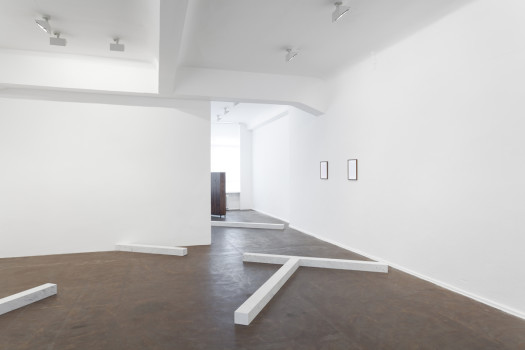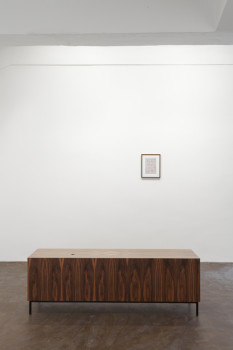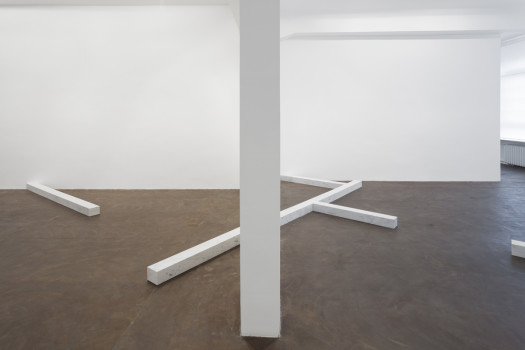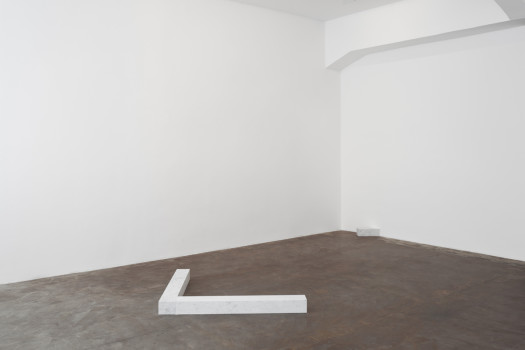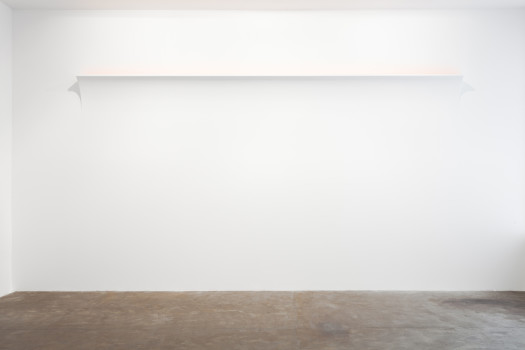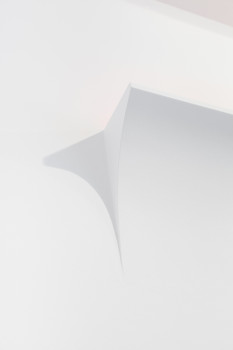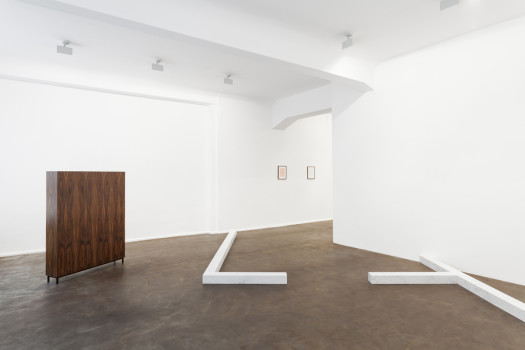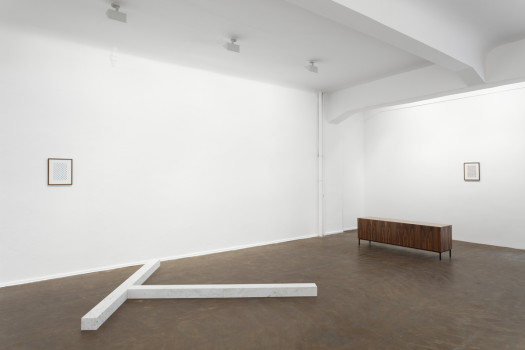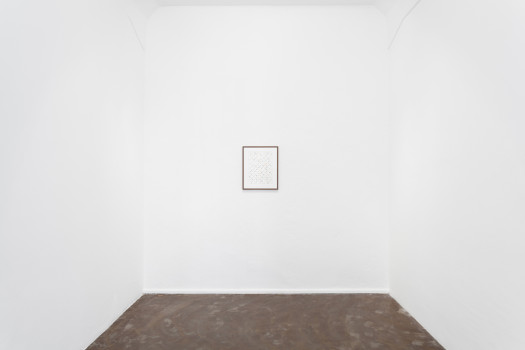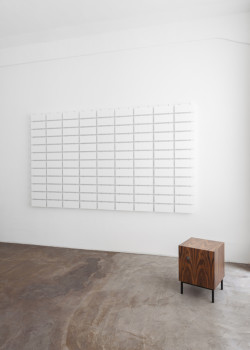Gallery exhibition
Carla Arocha & Stéphane Schraenen
Trace
more about
Carla Arocha & Stéphane Schraenen Credenza, 2013
Palisander, Mdf and enameled steel, 60 x 180 x 45 cm; In Pink and Blues, 2013, Ink on paper, 26 x 18 cm
Carla Arocha & Stéphane Schraenen Frieze III, 2015
Wood, Styrofoam, Polyester, acrylic; 37 x 500 x 17 cm
Carla Arocha & Stéphane Schraenen Frieze III, 2015
Wood, Styrofoam, Polyester, acrylic; 37 x 500 x 17 cm (detail)
Carla Arocha & Stéphane Schraenen Cabinet, Palisander, Mdf and enameled steel, 160 x 120 x 25 cm; Rooms II, 2010
Marble, dimensions variable
Carla Arocha & Stéphane Schraenen
Installation view: Credenza, Rooms 2, Works on Paper: In Pink and Blues, Boy
Galerie Isabella Czarnowska is pleased to announce the second solo exhibition of the Antwerp-based artists’ duo Carla Arocha & Stéphane Schraenen in its Berlin gallery space. The artists present a group of their works, virtually forming a synopsis of their artistic activities of the past years. The title Trace already conveys an impression of the character of the exhibition and the atmosphere it creates.
The works presented at the Galerie Isabella Czarnowska become an integral part of the exhibition space; conversely, the gallery space influences also the works. The artists moreover venture beyond the physical boundaries of the space and open it up for new and unknown dimensions. As a result, the exhibition exerts a seductive lure and provides aesthetic pleasure by receiving and integrating each of the forms on view. At the same time, it arouses suspicion and a feeling of uncertainty about what else will appear. The line between the utilitarian function of the architectonic space and a fictional, non-utilitarian one is very fine, and sometimes it is hard to tell where one ends and the other begins.
In the installation Frieze II, the wall looks as if it was being deliberately peeled away to expose an unknown source of light. Room II raises questions about the condition of historical memories and their contemporary character. A marble floor structure running across the entire gallery seems to allude to the foundations of another building. Perhaps the form refers to a building of the past, now existing as no more than a trace? Or why not think of it as an announcement of possible future events?
The Cabinet, Credenza and Bedside Table form a series of objects distributed throughout the gallery. Each of them features the finest palisander veneer. If at first sight they look like elegant pieces of furniture, on closer inspection we discover that the objects are non-functional. What is more, they have been perforated with perfectly round holes which lead the gaze right through to the other side. This singular gesture not only opens the objects up to new dimensions, but also emphasizes their non-functional character all the more strongly. A literal act of perforation, well known from everyday situations, means nothing more than the end of validity, and turns the furniture into useless objects but beautiful sculptures.
Earlier works by Carla Arocha & Stéphane Schraenen were presented in the exhibition “Caraota Von Moules” with Arturo Herrera at Künstlerhaus Bethanien, Berlin (2012); in their solo exhibition “Persiana”, summarizing a ten years survey, at the Cultuurcentrum Mechelen, Mechelen, Belgium (2014); in “Landscape” in the Sala Juarez at LARVA, Guadalajara, Mexico, and in the show “In A Rhythmic Fashion” at Gliptoteca, Croatian Academy of Sciences and Arts, Zagreb, Croatia (both 2015).
A catalogue entitled What Now? was published by the DISTANZ Verlag in conjunction with the first exhibition by Carla Arocha & Stéphane Schraenen at the Galerie Isabella Czarnowska in 2013. The catalogue is available at the gallery as well as in bookstores worldwide.
A catalogue Persiana, published by Ludion Publishers, Belgium accompanies the exhibition at the Cultuurcentrum Mechelen, Mechelen, Belgium in 2014.
Carla Arocha (b. 1961) was born in Caracas, Venezuela. From 1986 to 1990 she studied visual art at the Art Institute of Chicago, and subsequently she earned her master in fine arts at the University of Illinois 1994. Her collaboration with the Belgian artist Stéphane Schraenen began in 2005. Carla Arocha lives and works in Antwerp, Belgium.
Stéphane Schraenen (b. 1971) was born in Antwerp, Belgium, where he lives and works. In 1996 he embarked on studies at the Koninklijke Academie voor Schone Kunsten van Antwerpen (Antwerp Royal Academy of Fine Arts). His collaboration with Carla Arocha begann in 2005.
Die Galerie Isabella Czarnowska freut sich, die zweite Einzelausstellung des in Antwerpen arbeitenden Künstlerduos
Carla Arocha & Stéphane Schraenen in ihren Berliner Galerieräumen anzukündigen. Die Künstler präsentieren eine Gruppe der Arbeiten der letzten Jahre. Schon der Trace [Spur] vermittelt einen Eindruck vom Wesen der Ausstellung und der Atmosphäre, die dort geschaffen wird.
Die in der Galerie Isabella Czarnowska gezeigten Arbeiten sind situationsspezifisch angelegt, d.h. sie werden zu einem integralen Bestandteil des Ausstellungsraums; ebenso beeinflussen die Galerieräume auch die gezeigten Werke. Die Künstler lassen sich also nicht von den physischen Grenzen der Galerieräume beschränken, sondern öffnen diese für neue und bisher unbekannte Dimensionen.
Auf diese Weise erhält die Ausstellung einen seltenen, verführerischen Reiz. Gleichzeitig wird sie möglicherweise ein Gefühl der Unsicherheit erregen und die Besucher werden sich von Objekt zu Objekt fragen, welche Überraschungen wohl noch zu erwarten sind. Die Ausstellung markiert eine feine Grenze zwischen der utilitaristischen Funktion des architektonischen Raums und einer nicht-utilitaristischen, ja fiktionalen Dimension. Und manchmal wird es schwer zu entscheiden sein, wo das eine endet und das andere beginnt.
In der Installation Frieze II sieht die Wand aus, als würde sie absichtlich abgeschält, um eine unbekannte Lichtquelle freizulegen. Room II stellt Fragen nach den Bedingungen von Erinnerung und Gedächtnis. Eine Marmorbodenstruktur, die sich durch die ganze Galerie zieht, scheint auf das Fundament eines anderen Gebäudes zu verweisen. Vielleicht bezieht sich die Form auf ein Gebäude aus der Vergangenheit, von dem nichts weiter als eine Spur geblieben ist? Oder ist es eher eine Ankündigung von möglichen Ereignissen der Zukunft?
Cabinet, Credenza und Bedside Table bilden eine Serie von Objekten, die über die Galerie verteilt sind. Jedes von ihnen ist mit einem sehr feinen Palisanderfurnier versehen. Auf den ersten Blick erscheinen sie wie elegante Möbelstücke, aber beim genaueren Hinblicken entdeckt man, dass die Möbel funktionslos sind. Zudem wurden sie mit perfekt runden Löchern perforiert, so dass der Blick durch sie hindurch auf die andere Seite gelenkt wird. Diese singuläre Geste öffnet diese Objekte nicht nur neuen Dimensionen, sondern betont auch deutlich ihre Funktionslosigkeit. Ein buchstäblicher Akt der Perforation bedeutet nichts weiter als das Ende gültiger Maßstäbe und verwandelt die Möbelstücke in nutzlose Objekte, aber schöne Skulpturen.
Frühere Arbeiten von Carla Arocha & Stéphane Schraenen wurde in der Ausstellung „Caraota Von Moules“ zusammen mit Werken von Arturo Herrera im Künstlerhaus Bethanien Berlin (2012) gezeigt sowie in der Einzelausstellung „Persiana“ im Cultuurcentrum Mechelen, Mechelen, Belgien (2014), einer Übersicht der zehnjärigen Zusammenarbeit; in “Landscape” im Sala Juarez of the LARVA, Guadalajara, Mexiko, und in der Ausstellung „In A Rhythmic Fashion” in der Gliptoteca der Hrvatska akademija znanosti i umjetnost (Kroatische Akademie der Wissenschaften und Künste) in Zagreb, Kroatien (beide 2015).
Der Katalog What Now? erschien anlässlich der ersten Ausstellung von Carla Arocha & Stéphane Schraenen in der Galerie Isabella Czarnowska 2013 im Distanz Verlag. Der Katalog ist in der Galerie wie auch in Buchhabdlungen weltweit erhältlich.
Der Katalog Persiana, herausgegeben vom Ludion Publishers, Belgien, erschin 2014 anlässlich der Ausstellung im Cultuurcentrum Mechelen, Mechelen, Belgien.
Carla Arocha (* 1961) wurde in Caracas, Venezuela, geboren. Von 1986 bis 1990 studierte sie Visual Arts am Art Institute of Chicago und machte dann ihren Master in Fine Arts an der University of Illinois im Jahr 1994. Ihre Zusammenarbeit mit dem belgischen Künstler Stéphane Schraenen begann 2005. Carla Arocha lebt und arbeitet in Antwerpen, Belgien.
Stéphane Schraenen (* 1971) wurde in Antwerpen, Belgien, geboren, wo er auch heute lebt und arbeitet. 1996 begann er sein Studium an der Koninklijke Academie voor Schone Kunsten van Antwerpen. Seine Zusammenarbeit mit Carla Arocha begann 2005.
Galerie Isabella Czarnowska w Berlinie ma przyjemność zaprosić na drugą indywidualną wystawę tworzącego w Antwerpii duetu: Carla Arocha & Stéphane Schraenen. Artyści zaprezentują na niej grupę swoich prac, reasymujących lata ich działalność artystycznej. Już tytuł wystawy Trace (w języku polskim: Ślad) nakierowuje na jej charakter i atmosferę.
Wszystkie zaprezentowane w przestrzeni galerii Isabella Czarnowska instalacje staną się integralną częścią przestrzeni galeryjnej zaś przestrzeń także nie pozostanie bez znaczenia dla samych prac. Ponadto artyści użyją pomieszczeń galeryjnych po to aby wyjść poza ich ograniczenia i sprawią, że zaistnieją w niej nowe, nieznane wymiary. Tym samym wystawa zacznie ujmować a oglądanie każdego jej elementu będzie estetycznie przyjemnym doznaniem. Niemniej jednak wiązać się będzie równocześnie z narastającym odczuciem niepewności a także złożonością tego co się jeszcze ujawni. Granica między użyteczną funkcją przestrzeni architektonicznej a tą fikcyjną i nieutylitarną stanie się bardzo płynna, także czasami trudno ocenić gdzie która z przestrzeni się zaczyna a kiedy się kończy.
Tak jak we Frieze II, instalacji, w której zdaje się, że ściana rozwarstwia się, po to aby odkryć nieznane źródło światła. Room II zaś stawia pytania o kondycję zaprzeszłych wspomnień oraz ich współczesny charakter. Marmurowe struktury, rozmieszone na prawie całej podłodze galerii, od razu przywodzą na myśl fundamenty innego budynku. Jednakże czy forma ta odnosi się do wcześniejszego budynku, który zamienił się z czasem w historyczne ślady przeszłości? A może to zapowiedź przyszłych wydarzeń i możliwej historii, tej która mogłaby się jeszcze wydarzyć? Serię obiektów: Cabinet (Sekretarzyk), Credenza (Kredens) i Bedside Table (Stolik Nocny), rozstawionych w przestrzeni galerii, pokrywa warstwa pięknego, palisandrowego forniru. Od razu przywodzi ona na myśl komplet eleganckich mebli. Jednak po bliższym oglądzie wychodzi na jaw, że obiekty te są użytecznie niewartościowe. Dodatkowo, w każdym z nich zrobiony został idealnie okrągły otwór, dzięki któremu można przejrzeć je na wylot. Ten pojedynczy gest, nie tylko otwiera prace na nowy wymiar, ale podkreśla jeszcze bardziej ich niefunkcjonalny charakter. Dosłowny gest przedziurkowania, tak dobrze znany z codziennych sytuacji, zaznacza kres wartości mebli i przemienia w bezużyteczne obiekty ale piękne rzeźby.
Instalacje Carli Arocha i Stéphana Schraenen były prezentowane na wystawie “Caraota Von Moules” wspólnie z Arturo Herrera w Künstlerhaus Bethanien, Berlin 2012; na indywidualnej wystawie “Persiana”, podsumowującej dziesięć lat współpracy, w Cultuurcentrum Mechelen, Mechelen, Belgia (2014); na wystawie “Landscape” w Sala Juarez w LARVA, Guadalajara, Meksyk oraz na „In A Rhytmic Fashion“ w Gliptoteca Chorwacka Akademia Nauk i Sztuk, Zagrzeb, Chorwacja (obydwie w 2015).
W 2013 roku, w ramach pierwszej indywidualnej wystawy Carli Arocha i Stéphana Schraenen w Galerie Isabella Czarnowska został, nakładem wydawnictwa DISTANZ, wydany katalog What Now?. Katalog dostępny jest w galerii jak również i w księgarniach na całym świecie.
Wystawie w Cultuurcentrum Mechelen, Mechelen, Belgia towarzyszy katalog Persiana, wydany w 2014 roku przez wydawnictwo Ludion Publisher, Belgia.
Carla Arocha (ur. 1961) urodziła się w Caracas, Wenezuela. Od 1986 do 1990 studiowała sztuki wizualne w Art Institute of Chicago, zaś następnie zdobyła tytuł magistra sztuk pięknych na uniwersytecie w Illinois. Jej współpraca z belgijskim artystą Stéphanem Schraenen rozpoczęła się w 2005 roku. Carla Arocha mieszka i pracuje w Antwerpii, Belgia.
Stéphane Schraenen (ur. 1971) urodził się w Antwerpii, Belgia, gdzie mieszka i tworzy do tej pory. W 1996 roku rozpoczął studia na Antwerpskiej Królewskiej Akademii Sztuk Pięknych. Jego współpraca z Carlą Arocha rozpoczęła się w 2005 roku.
